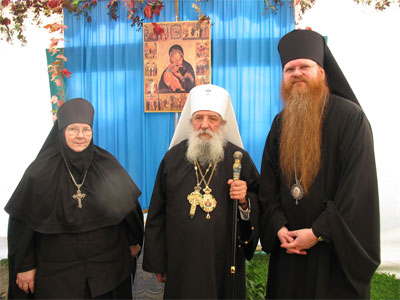New Rome: Vivacious Vestments
I knew I should have written a post on Byzantine vestments when thinking up this series.
 1. Why do Orthodox priests have beards?
1. Why do Orthodox priests have beards?As one can see from any icon of Christ, our Lord had a beard. Since the priest dispenses sacramental grace, he is an icon of Christ and should physically resemble our Lord by being bearded and having the same hairstyle (long and parted down the middle).
 2. Why does the Ecumenical Patriarch carry that cool staff?
2. Why does the Ecumenical Patriarch carry that cool staff?The staff the Patriarch carries is a crosier, and usage is akin to its Western counterpart. It is the symbol of the governing office of a bishop.
It comprises of two serpents/dragons curled around a small cross, remembering the bronze serpents Moses made in Numbers 21:9-9.
There is another form of the crosier, carried mostly by Russian bishops. It is tau-shaped with drooping arms and surmounted by a small cross.
 3. Is the hat similar in usage/symbolism to the papal tiara?
3. Is the hat similar in usage/symbolism to the papal tiara?The headgear in question is a mitre. Just as in the West, it signifies the temporal authority of bishops. Its shape is based on the closed imperial crown of the late Byzantine Empire. The design of the papal tiara is said to have been derived from the Byzantine mitre. As to whether they share similar symbolism, the answer would be no.
The papal tiara symbolises the papacy and the triple crowns represent the threefold authority of the pope. The Orthodox East, however, does not have an equivalent office.
The mitre is almost always worn only by bishops, but is also awarded to archpriests, protopresbyters and archimandrites at the discretion of the local synod. Unlike the episcopal mitre, the priestly mitre is not surmounted by a cross.
 4. What's the big cape?
4. What's the big cape?It is the mantle, the distinctive garment worn by monastics at various services, including vespers. It is not worn when serving the Divine Liturgy.
Monks wear the plain black mantle; the mantle of a hegumen (abbot) or an archimandrite may have crosses on the front. In the Slavic tradition (I am not familiar with the Greek), the different ranks of bishops use different colours - red for bishops, purple for archbishops, blue for metropolitans and green for patriarchs. Bishops generally don the mantle when formally entering a church or when he is attending a service he is not serving.
The episcopal mantle is characteristically decorated with red and white ribbons (called 'streams', symbolizing the word going out into the entire world) and four rectangular embroidered appliqués, two at the neck and two at the feet (called 'tablets', symbolizing the Gospel which must be the focus of a bishop's teachings).
 5. How do you tell the different ranks of clergy when not in liturgical vestment?
5. How do you tell the different ranks of clergy when not in liturgical vestment?Yes, it is very difficult to distinguish bishops from priests since almost every Orthodox cleric (nuns included) dress in black. The easiest way to tell a clergyman's rank would be to look for the engolpion (εγκόλπιον - lit. "on the chest") worn around the neck. Generally speaking, it is anything worn upon the bosom, but in recent times, it refers to the medallion with an icon in its centre, worn by bishops.
Often called a panagia, because all bishops wear a particular kind of engolpion which depicts the All-Holy Virgin Mary. Primates (i.e. archbishops) and certain bishops are bestowed the dignity of a second engolpion, which usually depicts our Lord.
Priests are usually recognised by the pectoral cross. This is not often the case, however - in Greek tradition, the pectoral cross is awarded only to archpriests; in the Russian, however, a silver cross is given upon ordination. Gold or decorated (i.e. jewelled) crosses are usually worn by higher ranking priests. A priest may sometimes be awarded with a second pectoral cross, which he may wear along with the first.
 Left to right: Ihumenia Makrina, Metropolitan Laurus & Bishop Agapit
Left to right: Ihumenia Makrina, Metropolitan Laurus & Bishop AgapitBishops are entitled to wear the pectoral cross, but most simply wear a panagia when not vested. Patriarchs wear all 3 - both engolpion of Christ and His Mother & a pectoral cross - when vested and occasionally when not. The hegumen (abbot) and hegumeni (abbess) of monasteries are also entitled to wear the pectoral cross.
Men dressed in cassocks, but lacking pectoral cross, are usually either seminarians, monks, deacons or Greek priests.




2 Comments:
Thank you, I've been Orthodox 10 years, and I learned some info from this post.
I'm with Mimi... thanks for the informative post!!!
Post a Comment
<< Home